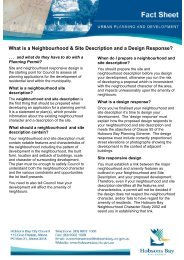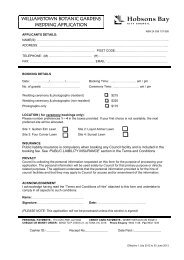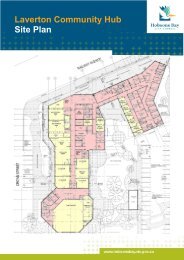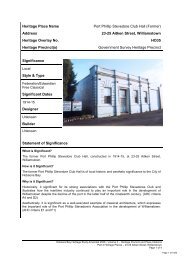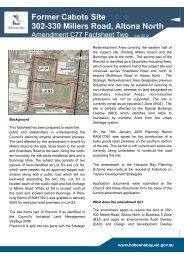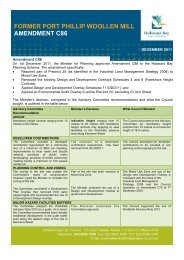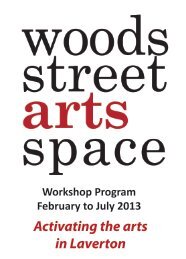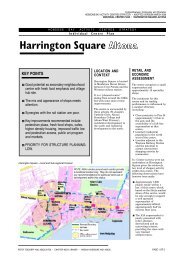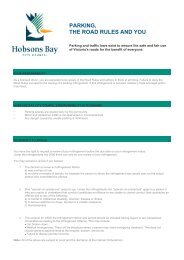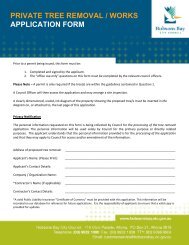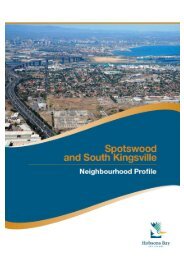Sustainable - Hobsons Bay
Sustainable - Hobsons Bay
Sustainable - Hobsons Bay
You also want an ePaper? Increase the reach of your titles
YUMPU automatically turns print PDFs into web optimized ePapers that Google loves.
Chapter 4<br />
S U S TA I N A B L E TO U R I S M<br />
<strong>Sustainable</strong> tourism has the potential to create vibrant<br />
and economically healthy communities. However<br />
there is growing concern within some communities<br />
about the potential negative impacts of tourism. This<br />
concern has increased in line with the rapid growth<br />
in mass tourism globally over the past 30 or so years<br />
(while noting a more recent contraction in domestic<br />
tourism and a slow down in international visitation to<br />
Australia (see chapter 5).<br />
As a result of the<br />
growing awareness of the<br />
environmental and social<br />
impacts of tourism it is<br />
now generally accepted that<br />
tourism planning should take<br />
into account the potential<br />
social and environmental<br />
impacts as well as the<br />
economic benefits of tourism<br />
development activities.<br />
The emergence of the term ‘sustainable tourism’<br />
is now used to describe this more broadly based<br />
approach to tourism development. It can be defined as<br />
economic development that will not impede the ability<br />
of future generations to meet their needs and enjoy a<br />
comparable or better quality of life and environment.<br />
The emphasis is on tourism that considers cultural<br />
factors, and fosters and supports conservation and<br />
ecologically responsible development. It means<br />
adopting tourism planning principles that increase<br />
both visitor satisfaction and improvements to the<br />
community.<br />
In regional Victoria, Beechworth is a good example of<br />
sustainable tourism development. By being innovative<br />
and embracing tourism, Beechworth has transformed<br />
from a contracting community based on institutional<br />
employment to a major tourism centre with a growing<br />
population and employment opportunity and diversity. 1<br />
From an environmental perspective, travel and tourism<br />
were identified in Agenda 21 2 as one of the few<br />
industries that have the potential to make a positive<br />
contribution to a healthier planet.<br />
The environmental benefits of tourism include:<br />
• The opportunity to communicate the value of<br />
natural and built heritage and of cultural<br />
inheritance to residents.<br />
• Enhancement of the natural and built<br />
environment to meet rising quality standards<br />
necessary to sustain modern tourism.<br />
• Providing the incentive for environmental<br />
enhancement or rehabilitation of areas such as<br />
town/city centres and old industrial sites,<br />
including the creation of employment in these<br />
areas.<br />
• Cost savings to individual tourism businesses<br />
through the adoption of waste and energy<br />
minimisation practices.<br />
• Protecting and creating economic value for<br />
resources which otherwise have no perceived<br />
value to residents, or represent a cost rather than<br />
a benefit.<br />
• Raising awareness of environmental issues and<br />
stimulating tourists to advocate for conservation<br />
through education and interpretation.<br />
Environmental appreciation can in turn enhance<br />
visitor enjoyment.<br />
The practical aspects of applying a sustainable<br />
development policy are reflected in Council’s City<br />
Plan 2005–2008. The plan uses a triple bottom line<br />
approach that focuses on achieving best practice by<br />
balancing economic, social and environmental goals<br />
and accomplishments so as to ensure the future<br />
sustainability of the municipality. 3<br />
The City Plan supports sustainable economic<br />
development and tourism opportunities. More<br />
specifically, Council strategies support economic<br />
development and tourism opportunities that:<br />
Table 1: <strong>Hobsons</strong> <strong>Bay</strong> key sustainable development objectives and strategies<br />
OBJECTIVE<br />
To maintain and enhance the<br />
natural and built environment<br />
for today and future<br />
generations.<br />
Protect existing<br />
neighbourhood<br />
character and ensure<br />
appropriate future<br />
development.<br />
STRATEGY<br />
• Enhance the urban environment through the greening of<br />
the Municipality.<br />
• Protect our natural environment and move towards more<br />
sustainable use of resources.<br />
• Provide a quality open space network across the<br />
municipality and promote our unique coastal parklands.<br />
• Ensure environmentally responsible & effective waste<br />
management and recycling practices.<br />
• Manage increased growth and development and ensure our<br />
strategies reflect heritage values and neighbourhood<br />
character.<br />
• Appropriately manage the implementation of Melbourne<br />
2030.<br />
A 2004 report by the Williamstown, Newport and Spotswood<br />
Residents’ Association into the community’s attitude to tourism<br />
(amongst other related topics) highlighted strong community<br />
support for sustainable tourism development in the municipality. 4<br />
The key findings and recommendations of the report are reflected in this Plan.<br />
• Capitalise on <strong>Hobsons</strong> <strong>Bay</strong>’s natural assets.<br />
• Create high value employment opportunities.<br />
• Promote and enhances community pride and<br />
sense of belonging.<br />
• Promote the artistic and cultural life of the City.<br />
The commitment to sustainable development is<br />
reflected in Council’s key development objectives and<br />
strategies for 2005/09, as noted in the following table.<br />
1<br />
Victoria’s Tourism Industry Strategic Plan 2002-2006. Tourism Victoria. pps 11-13.<br />
2<br />
Op cit. p 13. Agenda 21 is a program of action adopted by 182 governments at the 1992 United Nations Conference on Environment<br />
and Development (UNCED) Earth Summit.<br />
3<br />
<strong>Hobsons</strong> <strong>Bay</strong> City Plan 2005 - 2008.<br />
4<br />
From The Bridge to the Beach - Towards <strong>Sustainable</strong> Local Tourism. Williamstown, Newport & Spotswood Residents Assoc Inc. June 2004. Refer<br />
Attachment 2. Literature review for further details.<br />
10 11



